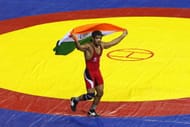The people from this tiny north Indian state could once boast of only the Haryana Hurricane – Kapil Dev – as the biggest sporting icon to have emerged from their province. But times have changed. Now they can be forgiven if they fail to rattle off the names of all their champions at one go, for such has been the dominance of Haryanvi sportsmen over the last decade. Delving deep into the distant past reveals that epic battles were fought on their land, which had changed the course of history. The Battle of Kurukshetra from the Mahabharat and the three clashes at Panipat have perhaps shaped the modern day Haryanvi into a person with distinctive martial traits. He is robust, curt and brassy. Be it his sturdy stature, passion for sports, prospect of jobs, family support, or incentives from the government, the Haryanvi is crowning himself in glory in whichever sport he plays.
Among the 81 members of the Indian contingent at London 2012, 18 hail from Haryana, a state with a share of just 2% of the national population. Leaving out MC Mary Kom and Vijay Kumar, the other 4 medalists from London are either from Haryana or have their roots there. So what has been the secret of Haryana’s success?
Despite always excelling in sports, the recent upsurge of world-beating athletes from this landlocked and primarily agricultural state has been driven by a few interlinking factors. Firstly, the agricultural condition has not always been this opulent in Haryana. It was the Green Revolution of the 1970s that saw the state make the biggest contribution to India becoming self-sufficent in food production. Gradually, the abundance of agricultural and dairy products helped build a rich diet amongst the sportspersons. Also, the minimal use of fertilisers in their crops ensures that the food is toxin-free. During the 2010 Commonwealth Games in New Delhi, the chants of “Doodh dahi ka khana hai, apna des Haryana hai” perhaps best explain the resplendent wrestlers and boxers that have emerged from the state. Haryana contributed no less than 22 of the 38 golds that India won at the Games.
Before the agricultural boom, a majority of the young generation used to join the Army to fulfill financial duties towards the family. There they exhibited their proficiency in sports and soon the Army produced national champions and Olympians like Captain Udey Chand, Balbir Singh, and Captain Hawa Singh. These icons from the past now groom the budding pugilists and grapplers.
While passion, focus and determination are essential, the lack of financial backing can severely dent success in sports. The Green Revolution also meant that the socio-economic conditions of the families would improve by leaps and bounds. Not surprisingly, the state boasts of the most number of rural Indian crorepatis, which stands at almost 500 now.
While the Yogeshwars, Vijenders and Sushils are ample in number, the women of Haryana aren’t too far behind either. If the wily character of Komal Chautala (perhaps portraying 2002 CWG gold-medalist Mamta Kharab) from Chak De! India is any evidence, the sportswomen from the state are as sturdy and strong-willed as the men. In a state where female foeticide is still a major concern, and the dominant rule of the khep panchayats overpowers law, the performances of the Saina Nehwals, Krishna Poonias and Geeta Phogats gives hope to the darkness that engulfs their women. With such inspiring achievements, the treatment of the women, as well as their own downtrodden attitude is now taking a turn for the better.
The stable state government under Chief Minister Bhupinder Singh Hooda has played a key role by offering jobs in the police department to athletes. This assurance of job security is a source of encouragment for more youths to take up sports as a definitive career. There are already 14 DSPs among the leading athletes. Also, the generous cash rewards shelled out by the government to the medal winners have gone down well with the present and aspiring sportsmen. As far as the London Games heroes are concerned, silver medalist Sushil Kumar was awarded 1.5 crore, while Saina Nehwal, Gagan Narang and Yogeshwar Dutt received a crore each for their bronze medals.
The government has started a talent hunt initiative to spot grassroot talent as well as nurture budding teen athletes to sharpen their skills. Even the insurgency in Punjab and the subsequent mass exodus of youths to the West had the historical effect of Haryana gradually outshining Punjab in the athletics field.
All in all, armed with a phalanx of international stars and rolling out many more, Haryana is now the athletics engine of India. Come Rio de Janeiro 2016, one would not only expect medals in double digits from the state, but also hope the rest of the country follows suit and contributes towards India’s ascendency at the Olympic Games.

